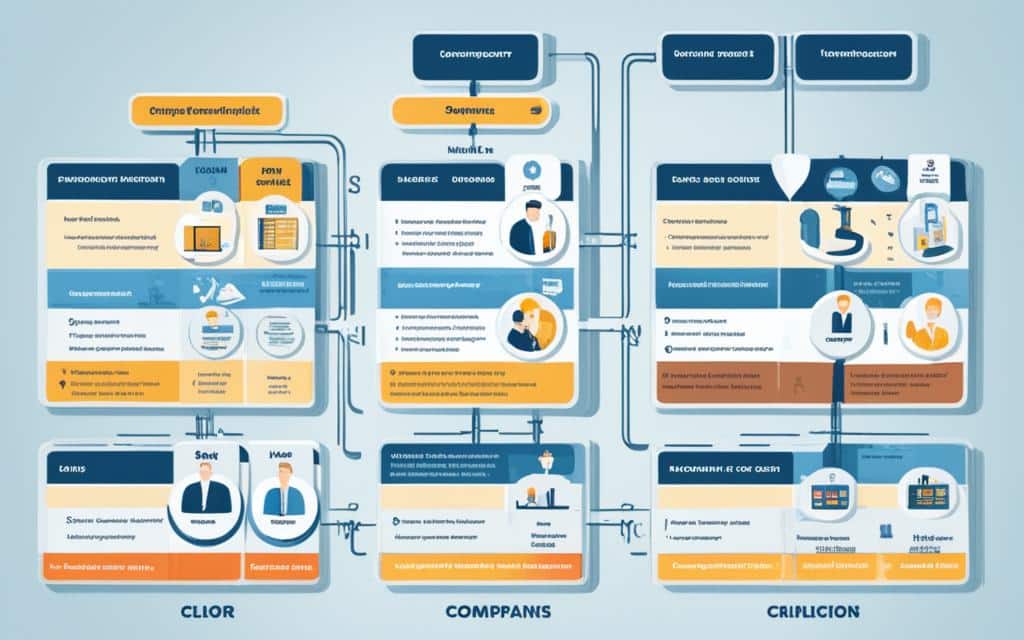Welcome to our comprehensive guide on workplace hierarchy in the UK. In this article, we will dive into the intricacies of how British businesses are organized and the role this structure plays in shaping their dynamics. Whether you’re a seasoned professional or just starting your career, understanding the hierarchical structure of the workplace is crucial for navigating the dynamics and progressing within your chosen field.
From large corporations to small businesses, the workplace hierarchy in the UK follows a well-defined structure that helps establish clear lines of authority and facilitates effective decision-making processes. It plays a significant role in enhancing productivity and ensuring the smooth functioning of organizations.
Throughout this article, we will explore the different levels of hierarchy commonly found in UK workplaces, the communication and collaboration processes within this structure, as well as the advantages and challenges it presents. Additionally, we will discuss potential future trends and developments that might impact the traditional hierarchical system.
So, if you’re ready to gain a deeper understanding of the workplace hierarchy structure in the UK, let’s dive into the fascinating world of organizational dynamics.
The Importance of Workplace Hierarchy
In the context of UK workplaces, a well-defined and organized hierarchical structure plays a crucial role in establishing clear lines of authority and promoting effective decision-making processes. This structure serves as the backbone of an organization, enabling it to operate smoothly and efficiently.
One of the key benefits of a workplace hierarchy is the establishment of clear reporting relationships. With designated levels of authority and responsibility, employees know who to report to and who holds decision-making power. This clarity helps in streamlining communication and prevents confusion or conflicts that may arise from the lack of a structured hierarchy.
The workplace hierarchy structure also facilitates effective decision-making. When responsibilities and decision-making authority are distributed across different levels, decisions can be made quickly and efficiently. Lower-level employees can focus on their specific tasks while higher-level managers can make more strategic decisions, creating a balance between operational and strategic functions.
Moreover, a well-implemented workplace hierarchy can increase productivity among employees. It establishes accountability and provides individuals with a clear understanding of their roles and responsibilities. This clarity helps employees prioritize tasks, manage their time effectively, and work towards common goals, ultimately contributing to improved productivity and efficiency.
In summary, a structured workplace hierarchy is vital in the UK as it promotes clear lines of authority, facilitates decision-making processes, and enhances productivity among employees. It provides a solid framework for effective communication, efficient operations, and organizational success.
Levels of Hierarchy in the UK Workplace
In the UK workplace, a hierarchical structure is prevalent, with various levels of authority and responsibility. Understanding these levels of hierarchy is crucial for employees to navigate their careers and for organizations to function effectively.
At the top of the hierarchy, we have the executives or senior management. These are the decision-makers who hold the highest level of authority and are responsible for setting the overall direction and strategy of the organization.
Below the executives, we find middle managers who oversee specific departments or teams within the company. They act as a bridge between the executives and the employees, ensuring that strategic goals are translated into actionable plans and coordinating the day-to-day operations.
Next in the hierarchy are supervisors or team leaders who directly manage a group of employees. They provide guidance, assign tasks, and assess performance, playing a crucial role in maintaining productivity and quality within their teams.
- Executives
- Middle Managers
- Supervisors or Team Leaders
At the base of the hierarchy are the employees who carry out the tasks and responsibilities assigned to them by their supervisors. They contribute their skills and expertise to the overall success of the organization.
It’s important to note that not all organizations have the same exact hierarchical structure. Some companies may have additional levels or different job titles to accommodate their specific industry or organizational needs. However, the general framework outlined above provides a basis for understanding the levels of hierarchy commonly found in UK workplaces.
By having a clearly defined hierarchy, organizations can establish a chain of command, promote accountability, and facilitate efficient decision-making processes. Employees can also have a clear understanding of their roles, responsibilities, and career progression within the company.
Communication and Collaboration within the Hierarchy
Effective communication and collaboration are crucial aspects of a well-functioning workplace hierarchy structure in the UK. In this section, we will explore how these elements are managed within the hierarchy and their significant role in achieving organizational goals.
Communication within the hierarchy ensures that information flows smoothly between different levels of the organization. It involves the exchange of ideas, instructions, feedback, and updates, enabling employees to stay informed and aligned with the overall objectives.
Managers play a pivotal role in facilitating effective communication within the workplace hierarchy. They serve as intermediaries between upper management and employees, conveying information, delegating tasks, providing guidance, and addressing concerns. By fostering an open and transparent communication culture, managers create an environment where employees feel comfortable sharing their thoughts and ideas.
A key aspect of effective communication within the workplace hierarchy is the art of active listening. Managers must actively listen to their subordinates, understanding their perspectives, concerns, and challenges. By acknowledging and addressing these issues, managers can nurture a positive work environment, promote teamwork, and boost employee morale.
Collaboration is another essential component of the workplace hierarchy structure in the UK. It involves individuals working together towards a common goal, leveraging their diverse skills and expertise. Effective collaboration encourages creativity, innovation, and problem-solving by harnessing the collective intelligence of the workforce.
Teamwork and collaboration are often fostered through cross-functional projects, where employees from different departments collaborate to tackle complex challenges. By breaking down silos and encouraging interdisciplinary collaboration, organizations can tap into the full potential of their workforce, resulting in improved efficiency and a more competitive edge.
Importance of Teamwork in Achieving Organizational Goals
Teamwork plays a vital role in achieving organizational goals within the workplace hierarchy structure. By pooling together individual strengths and resources, teams can accomplish tasks efficiently, often surpassing what individuals can achieve alone.
Teams facilitate the sharing of knowledge, best practices, and resources, leading to increased efficiency and productivity. They also provide a platform for employees to learn from each other, foster trust, and build stronger relationships. Collaboration within teams encourages open communication, respect for diverse perspectives, and a sense of shared responsibility.
Furthermore, teamwork enables organizations to adapt more effectively to changes and challenges. By having individuals with different perspectives and expertise working together, organizations can generate innovative solutions and respond swiftly to evolving market demands. This flexibility and agility are critical in today’s rapidly changing business landscape.
In summary, effective communication and collaboration are essential for the smooth functioning of the workplace hierarchy structure in the UK. Strong managerial communication practices, active listening, and fostering collaboration can promote a positive work environment, facilitate knowledge sharing, and drive organizational success.
Advantages and Challenges of Workplace Hierarchy in the UK
When examining the workplace hierarchy structure in the UK, it is essential to consider the advantages and challenges it presents. Understanding these aspects can provide valuable insights into the dynamics of British businesses and their organizational effectiveness.
The Advantages of Workplace Hierarchy in the UK
One of the primary benefits of a hierarchical structure is the clarity it offers. With clearly defined roles and reporting lines, employees have a clear understanding of their responsibilities and who they report to for guidance and decision-making. This clarity fosters a sense of direction and accountability, leading to increased efficiency and productivity within the organization.
Furthermore, workplace hierarchy promotes a sense of order and stability. By having a structured chain of command, companies can effectively distribute authority, ensuring decisions are made by individuals with the necessary expertise and knowledge. This hierarchical arrangement supports effective decision-making and streamlines the workflow, minimizing confusion and preventing conflicts that may arise from a lack of clear authority.
Another advantage of workplace hierarchy in the UK is the potential for career progression. The hierarchical structure provides a visible path for employees to advance within the organization. This encourages ambition, motivation, and a sense of goal-oriented growth, leading to increased employee satisfaction and loyalty.
The Challenges of Workplace Hierarchy in the UK
However, while workplace hierarchy offers numerous benefits, it is not without its challenges. One of the primary drawbacks is the potential rigidity and lack of flexibility that can arise from a strict hierarchical structure. This rigidity can hinder innovation and adaptability, as subordinates may be hesitant to challenge the decisions or suggestions of higher-ranking individuals. This lack of open communication and collaborative problem-solving can impede creativity and hinder the organization’s ability to navigate complex and rapidly changing business environments.
Additionally, workplace hierarchy can unintentionally foster a culture of competition rather than collaboration. The emphasis on climbing the corporate ladder can create an environment where employees are more focused on personal success and recognition, potentially leading to strained relationships and a decreased sense of teamwork.
It is important for organizations to strike a balance between hierarchy and fostering a collaborative and inclusive workplace culture. By adopting more flexible structures and encouraging open communication and idea-sharing across all levels, businesses can mitigate the challenges of workplace hierarchy while capitalizing on its advantages.
As we continue to analyze the workplace hierarchy structure in the UK, it is crucial to consider the nuances and complexities that come with it. By understanding the advantages and challenges of this organizational framework, businesses can make informed decisions to optimize their performance and create an environment that nurtures both individual growth and collective success.
Future Trends in UK Workplace Hierarchy
As the workplace landscape continues to evolve, the traditional hierarchy structure in the UK is facing potential transformations. Advancements in technology are reshaping the way we work, challenging the established order and opening up new possibilities for organizational structure.
One key trend shaping the future of workplace hierarchy in the UK is the increasing role of remote work and flexible schedules. With a growing number of businesses adopting flexible working arrangements, the traditional top-down pyramid structure may give way to a more distributed and autonomous model. This shift allows employees to have greater control over their work-life balance and promotes a culture of trust and independence.
Another notable trend is the emphasis on inclusivity and diversity within the workplace. Organizations are recognizing the importance of creating an environment where everyone feels valued and has an equal opportunity to contribute. As a result, the hierarchical structure is likely to become more fluid, with a greater focus on collaboration and shared decision-making across different levels of the organization.
Furthermore, the rise of digital platforms and virtual communication tools is revolutionizing the way teams collaborate and interact. The hierarchical structure may become more networked, with communication becoming less dependent on formal channels and more reliant on cross-functional teams and agile work practices. This shift allows for faster decision-making and greater innovation, as ideas and expertise can be shared more freely across the organization.












